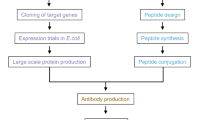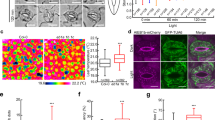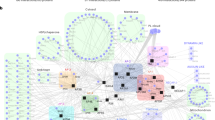Abstract
The endomembrane system is a complex and dynamic intracellular trafficking network. It is very challenging to track individual vesicles and their cargos in real time; however, affinity purification allows vesicles to be isolated in their natural state so that their constituent proteins can be identified. Pioneering this approach in plants, we isolated the SYP61 trans-Golgi network compartment and carried out a comprehensive proteomic analysis of its contents with only minimal interference from other organelles. The proteome of SYP61 revealed the association of proteins of unknown function that have previously not been ascribed to this compartment. We identified a complete SYP61 SNARE complex, including regulatory proteins and validated the proteome data by showing that several of these proteins associated with SYP61 in planta. We further identified the SYP121-complex and cellulose synthases, suggesting that SYP61 plays a role in the exocytic trafficking and the transport of cell wall components to the plasma membrane. The presence of proteins of unknown function in the SYP61 proteome including ECHIDNA offers the opportunity to identify novel trafficking components and cargos. The affinity purification of plant vesicles in their natural state provides a basis for further analysis and dissection of complex endomembrane networks. The approach is widely applicable and can afford the study of several vesicle populations in plants, which can be compared with the SYP61 vesicle proteome.
Similar content being viewed by others
Log in or create a free account to read this content
Gain free access to this article, as well as selected content from this journal and more on nature.com
or
References
Hicks GR, Raikhel NV . Advances in dissecting endomembrane trafficking with small molecules. Curr Opin Plant Biol 2010; 13:706–713.
Richter S, Voss U, Jurgens G . Post-Golgi traffic in plants. Traffic 2009; 10:819–828.
Irani NG, Russinova E . Receptor endocytosis and signaling in plants. Curr Opin Plant Biol 2009; 12:653–659.
Geldner N, Robatzek S . Plant receptors go endosomal: a moving view on signal transduction. Plant Physiol 2008; 147:1565–1574.
Dettmer J, Hong-Hermesdorf A, Stierhof YD, Schumacher K . Vacuolar H+-ATPase activity is required for endocytic and secretory trafficking in Arabidopsis. Plant Cell 2006; 18:715–730.
Viotti C, Bubeck J, Stierhof YD, et al. Endocytic and secretory traffic in Arabidopsis merge in the trans-Golgi network/early endosome, an independent and highly dynamic organelle. Plant Cell 2010; 22:1344–1357.
Niemes S, Langhans M, Viotti C, et al. Retromer recycles vacuolar sorting receptors from the trans-Golgi network. Plant J 2010; 61:107–121.
Ito J, Batth TS, Petzold CJ, et al. Analysis of the Arabidopsis cytosolic proteome highlights subcellular partitioning of central plant metabolism. J Proteome Res 2011; 10:1571–1582.
Dunkley TP, Hester S, Shadforth IP, et al. Mapping the Arabidopsis organelle proteome. Proc Natl Acad Sci USA 2006; 103:6518–6523.
Carter C, Pan S, Zouhar J, et al. The vegetative vacuole proteome of Arabidopsis thaliana reveals predicted and unexpected proteins. Plant Cell 2004; 160:3285–3303.
Eubel H, Heazlewood JL, Millar AH . Isolation and subfractionation of plant mitochondria for proteomic analysis. Methods Mol Biol 2007; 355:49–62.
Eubel H, Meyer EH, Taylor NL, et al. Novel proteins, putative membrane transporters, and an integrated metabolic network are revealed by quantitative proteomic analysis of Arabidopsis cell culture peroxisomes. Plant Physiol 2008; 148:1809–1829.
Kleffmann T, Russenberger D, von Zychlinski A, et al. The Arabidopsis thaliana chloroplast proteome reveals pathway abundance and novel protein functions. Curr Biol 2004; 14:354–362.
Steuble M, Gerrits B, Ludwig A, et al. Molecular characterization of a trafficking organelle: dissecting the axonal paths of calsyntenin-1 transport vesicles. Proteomics 2010; 10:3775–3788.
Bassham DC, Sanderfoot AA, Kovaleva V, Zheng H, Raikhel NV . AtVPS45 complex formation at the trans-Golgi network. Mol Biol Cell 2000; 11:2251–2265.
Sanderfoot AA, Kovaleva V, Bassham DC, Raikhel NV . Interactions between syntaxins identify at least five SNARE complexes within the Golgi/prevacuolar system of the Arabidopsis cell. Mol Biol Cell 2001; 12:3733–3743.
Robert S, Chary SN, Drakakaki G, et al. Endosidin1 defines a compartment involved in endocytosis of the brassinosteroid receptor BRI1 and the auxin transporters PIN2 and AUX1. Proc Natl Acad Sci USA 2008; 105:8464–8469.
Zhu JH, Gong ZZ, Zhang CQ, et al. OSM1/SYP61: A syntaxin protein in Arabidopsis controls abscisic acid-mediated and non-abscisic acid-mediated responses to abiotic stress. Plant Cell 2002; 14:3009–3028.
Chen Y, Shin YK, Bassham DC . YKT6 is a core constituent of membrane fusion machineries at the Arabidopsis trans-Golgi network. J Mol Biol 2005; 350:92–101.
Morris JA, Dorner AJ, Edwards CA, Hendershot LM, Kaufman RJ . Immunoglobulin binding protein (BiP) function is required to protect cells from endoplasmic reticulum stress but is not required for the secretion of selective proteins. J Biol Chem 1997; 272:4327–4334.
da Silva Conceicao A, Marty-Mazars D, Bassham DC, et al. The syntaxin homolog AtPEP12p resides on a late post-Golgi compartment in plants. Plant Cell 1997; 9:571–582.
Weatherly DB, Atwood JA, 3rd, Minning TA, et al. A Heuristic method for assigning a false-discovery rate for protein identifications from Mascot database search results. Mol Cell Proteomics 2005; 4:762–772.
Rohila JS, Chen M, Chen S, et al. Protein-protein interactions of tandem affinity purified protein kinases from rice. PLoS One 2009; 4:e6685.
Cutillas PR, Vanhaesebroeck B . Quantitative profile of five murine core proteomes using label-free functional proteomics. Mol Cell Proteomics 2007; 6:1560–1573.
Silva JC, Denny R, Dorschel CA, et al. Quantitative proteomic analysis by accurate mass retention time pairs. Anal Chem 2005; 77:2187–2200.
Rojo E, Zouhar J, Kovaleva V, Hong S, Raikhel NV . The AtC-VPS protein complex is localized to the tonoplast and the prevacuolar compartment in Arabidopsis. Mol Biol Cell 2003; 14:361–369.
Paredez AR, Somerville CR . Ehrhardt DW . Visualization of cellulose synthase demonstrates functional association with microtubules. Science 2006; 312:1491–1495.
Whiteheart SW, Griff IC, Brunner M, et al. SNAP family of NSF attachment proteins includes a brain-specific isoform. Nature 1993; 362:353–355.
Zouhar J, Munoz A, Rojo E . Functional specialization within the Vacuolar Sorting Receptor family: VSR1, VSR3 and VSR4 sort vacuolar storage cargo in seeds and vegetative tissues. Plant J 2010; 64:577–588.
Yang X, Matern HT, Gallwitz D . Specific binding to a novel and essential Golgi membrane protein (Yip1p) functionally links the transport GTPases Ypt1p and Ypt31p. EMBO J 1998; 17:4954–4963.
Tang BL, Ong YS, Huang B, et al. A membrane protein enriched in endoplasmic reticulum exit sites interacts with COPII. J Biol Chem 2001; 276:40008–40017.
Kano F, Yamauchi S, Yoshida Y, et al. Yip1A regulates the COPI-independent retrograde transport from the Golgi complex to the ER. J Cell Sci 2009; 122:2218–2227.
Geldner N, Denervaud-Tendon V, Hyman DL, et al. Rapid, combinatorial analysis of membrane compartments in intact plants with a multicolor marker set. Plant J 2009; 59:169–178.
Pinheiro H, Samalova M, Geldner N, et al. Genetic evidence that the higher plant Rab-D1 and Rab-D2 GTPases exhibit distinct but overlapping interactions in the early secretory pathway. J Cell Sci 2009; 122:3749–3758.
Markgraf DF, Peplowska K, Ungermann C . Rab cascades and tethering factors in the endomembrane system. FEBS Lett 2007; 581:2125–2130.
Sztul E, Lupashin V . Role of tethering factors in secretory membrane traffic. Am J Physiol Cell Physiol 2006; 290:C11–26.
Thellmann M, Rybak K, Thiele K, Wanner G, Assaad FF . Tethering factors required for cytokinesis in Arabidopsis. Plant Physiol 2010; 154:720–732.
Wang W, Sacher M, Ferro-Novick S . TRAPP stimulates guanine nucleotide exchange on Ypt1p. J Cell Biol 2000; 151:289–296.
Holwerda BC, Padgett HS, Rogers JC . Proaleurain vacuolar targeting is mediated by short contiguous peptide interactions. Plant Cell 1992; 4:307–318.
Bednarek SY, Wilkins TA, Dombrowski JE, Raikhel NV . A carboxyl-terminal propeptide is necessary for proper sorting of barley lectin to vacuoles of tobacco. Plant Cell 1990; 2:1145–1155.
Shimada T, Fuji K, Tamura K, et al. Vacuolar sorting receptor for seed storage proteins in Arabidopsis thaliana. Proc Natl Acad Sci USA 2003; 100:16095–16100.
Avila EL, Brown M, Pan S, et al. Expression analysis of Arabidopsis vacuolar sorting receptor 3 reveals a putative function in guard cells. J Exp Bot 2008; 59:1149–1161.
Ahmed SU, Bar-Peled M, Raikhel NV . Cloning and subcellular location of an Arabidopsis receptor-like protein that shares common features with protein-sorting receptors of eukaryotic cells. Plant Physiol 1997; 114:325–336.
Hinz G, Colanesi S, Hillmer S, Rogers JC, Robinson DG . Localization of vacuolar transport receptors and cargo proteins in the Golgi apparatus of developing Arabidopsis embryos. Traffic 2007; 8:1452–1464.
Otegui MS, Herder R, Schulze J, Jung R, Staehelin LA . The proteolytic processing of seed storage proteins in Arabidopsis embryo cells starts in the multivesicular bodies. Plant Cell 2006; 18:2567–2581.
Miao Y, Yan PK, Kim H, Hwang I, Jiang L . Localization of green fluorescent protein fusions with the seven Arabidopsis vacuolar sorting receptors to prevacuolar compartments in tobacco BY-2 cells. Plant Physiol 2006; 142:945–962.
Niemes S, Langhans M, Viotti C, et al. Retromer recycles vacuolar sorting receptors from the trans-Golgi network. Plant J 2010; 61:107–121.
Foresti O, Gershlick DC, Bottanelli F, et al. A recycling-defective vacuolar sorting receptor reveals an intermediate compartment situated between prevacuoles and vacuoles in tobacco. Plant Cell 2010; 22:3992–4008.
Saint-Jean B, Seveno-Carpentier E, Alcon C, Neuhaus JM, Paris N . The cytosolic tail dipeptide Ile-Met of the pea receptor BP80 is required for recycling from the prevacuole and for endocytosis. Plant Cell 2010; 22:2825–2837.
Fasshauer D, Sutton RB, Brunger AT, Jahn R . Conserved structural features of the synaptic fusion complex: SNARE proteins reclassified as Q- and R-SNAREs. Proc Natl Acad Sci USA 1998; 95:15781–15786.
Collins NC, Thordal-Christensen H, Lipka V, et al. SNARE-protein-mediated disease resistance at the plant cell wall. Nature 2003; 425:973–977.
Kwon C, Neu C, Pajonk S, et al. Co-option of a default secretory pathway for plant immune responses. Nature 2008; 451:835–840.
Kwaaitaal M, Keinath NF, Pajonk S, Biskup C, Panstruga R . Combined bimolecular fluorescence complementation and Forster resonance energy transfer reveals ternary SNARE complex formation in living plant cells. Plant Physiol 2010; 152:1135–1147.
Leyman B, Geelen D, Quintero FJ, Blatt MR . A tobacco syntaxin with a role in hormonal control of guard cell ion channels. Science 1999; 283:537–540.
Wang J, Elliott JE, Williamson RE . Features of the primary wall CESA complex in wild type and cellulose-deficient mutants of Arabidopsis thaliana. J Exp Bot 2008; 59:2627–2637.
Crowell EF, Bischoff V, Desprez T, et al. Pausing of Golgi bodies on microtubules regulates secretion of cellulose synthase complexes in Arabidopsis. Plant Cell 2009; 21:1141–1154.
Gutierrez R, Lindeboom JJ, Paredez AR, Emons AM . Ehrhardt DW . Arabidopsis cortical microtubules position cellulose synthase delivery to the plasma membrane and interact with cellulose synthase trafficking compartments. Nat Cell Biol 2009; 11:797–806.
Toyooka K, Goto Y, Asatsuma S, et al. A mobile secretory vesicle cluster involved in mass transport from the Golgi to the plant cell exterior. Plant Cell 2009; 21:1212–1229.
Lam SK, Siu CL, Hillmer S, et al. Rice SCAMP1 defines clathrin-coated, trans-golgi-located tubular-vesicular structures as an early endosome in tobacco BY-2 cells. Plant Cell 2007; 19:296–319.
Gendre D, Oh J, Boutte Y, et al. Conserved Arabidopsis ECHIDNA protein mediates trans-Golgi-network trafficking and cell elongation. Proc Natl Acad Sci USA 2011; 108:8048–8053.
Robinson DG, Jiang LW, Schumacher K . The endosomal system of plants: Charting new and familiar territories. Plant Physiol 2008; 147:1482–1492.
Inadome H, Noda Y, Kamimura Y, Adachi H, Yoda K . Tvp38, Tvp23, Tvp18 and Tvp15: novel membrane proteins in the Tlg2-containing Golgi/endosome compartments of Saccharomyces cerevisiae. Exp Cell Res 2007; 313:688–697.
Kang BH, Nielsen E, Preuss ML, Mastronarde D, Staehelin LA . Electron tomography of RabA4b- and PI-4Kbeta1-Labeled trans golgi network compartments in Arabidopsis. Traffic 2010; 12:313–329.
Zabotina OA, van de Ven WT, Freshour G, et al. Arabidopsis XXT5 gene encodes a putative alpha-1,6-xylosyltransferase that is involved in xyloglucan biosynthesis. Plant J 2008; 56:101–115.
Drakakaki G, Zabotina O, Delgado I, et al. Arabidopsis reversibly glycosylated polypeptides 1 and 2 are essential for pollen development. Plant Physiol 2006; 142:1480–1492.
Voisin SN, Krakovska O, Matta A, et al. Identification of novel molecular targets for endometrial cancer using a drill-down LC-MS/MS approach with iTRAQ. PLoS One 2011; 6:e16352.
Clough SJ, Bent AF . Floral dip: a simplified method for Agrobacterium-mediated transformation of Arabidopsis thaliana. Plant J 1998; 16:735–743.
Sohn EJ, Rojas-Pierce M, Pan S, et al. The shoot meristem identity gene TFL1 is involved in flower development and trafficking to the protein storage vacuole. Proc Natl Acad Sci USA 2007; 104:18801–18806.
Heese M, Gansel X, Sticher L, et al. Functional characterization of the KNOLLE-interacting t-SNARE AtSNAP33 and its role in plant cytokinesis. J Cell Biol 2001; 155:239–249.
Tse YC, Mo B, Hillmer S, et al. Identification of multivesicular bodies as prevacuolar compartments in Nicotiana tabacum BY-2 cells. Plant Cell 2004; 16:672–693.
Wang J, Li Y, Lo SW, et al. Protein mobilization in germinating mung bean seeds involves vacuolar sorting receptors and multivesicular bodies. Plant Physiol 2007; 143:1628–1639.
Acknowledgements
We thank Drs Chris Somerville (UC Berkeley, USA), Niko Geldner (University of Lausanne, Switzerland), and Herman Höfte (INRA, France) for providing the transgenic Arabidopsis lines CESA6-YFP, RABD2b-YFP (Wave 33), and CESA3-GFP, respectively. We also thank Drs Gerd Jürgens (University of Tuebingen, Germany), Paul Schulze-Lefert (Max Planck Institute for Plant Breeding Research, Germany), Richard Williamson (Australian National University) for providing SNAP33, PEN1 (SYP121) and SYP72 and CESA1 antibodies. We thank Drs Thomas Girke (UC Riverside, USA), Brett S Phinney (UC Davis, USA) and Mark Gjukich (University of Michigan, USA) for their support on data deposition. This work was funded by a grant from the DOE (DEFG03-02ER15295) to NVR. GD was supported by UC Davis startup funds.
Author information
Authors and Affiliations
Corresponding author
Additional information
(Supplementary Information is linked to the online version of the paper on the Cell Research website.)
Supplementary information
Supplementary information, Figure S1
Fractionation of SYP61 vesicles. (PDF 45 kb)
Supplementary information, Figure S2
LC/MS quantitative analysis using MS spectra intensity derived from extracted ion chromatograms (XIC). (PDF 275 kb)
Supplementary information, Figure S3
SYP61 colocalizes with isolated components of SNARE complexes VPS45, SYP43, and the GTPase RABD2B. (PDF 123 kb)
Supplementary information, Figure S4
SYP61 colocalization with VSR2. (PDF 47 kb)
Supplementary information, Figure S5
Colocalization of SYP61 with CESA1 in Arabidopsis protoplasts. (PDF 45 kb)
Supplementary information, Figure S6
Colocalization of SYP61 with SCAMP. (PDF 84 kb)
Supplementary information, Table S1
Proteins detected in only SYP61 but not IgG (XLS 218 kb)
Supplementary information, Table S2
Proteins detected in both SYP61 and IgG fractions with 1% FDR (XLS 49 kb)
Supplementary information, Table S3
Primers used for cDNA amplifications (PDF 76 kb)
Supplementary information, Data S1
Materials and Methods (PDF 7 kb)
Rights and permissions
About this article
Cite this article
Drakakaki, G., van de Ven, W., Pan, S. et al. Isolation and proteomic analysis of the SYP61 compartment reveal its role in exocytic trafficking in Arabidopsis. Cell Res 22, 413–424 (2012). https://doi.org/10.1038/cr.2011.129
Received:
Revised:
Accepted:
Published:
Issue date:
DOI: https://doi.org/10.1038/cr.2011.129
Keywords
This article is cited by
-
Nanobody-based VSR7 tracing shows clathrin-dependent TGN to Golgi recycling
Nature Communications (2023)
-
In vitro reconstitution of COPII vesicles from Arabidopsis thaliana suspension-cultured cells
Nature Protocols (2023)
-
Actomyosin and CSI1/POM2 cooperate to deliver cellulose synthase from Golgi to cortical microtubules in Arabidopsis
Nature Communications (2023)
-
CEF3 is involved in membrane trafficking and essential for secondary cell wall biosynthesis and its mutation enhanced biomass enzymatic saccharification in rice
Biotechnology for Biofuels and Bioproducts (2022)
-
Connected function of PRAF/RLD and GNOM in membrane trafficking controls intrinsic cell polarity in plants
Nature Communications (2022)



